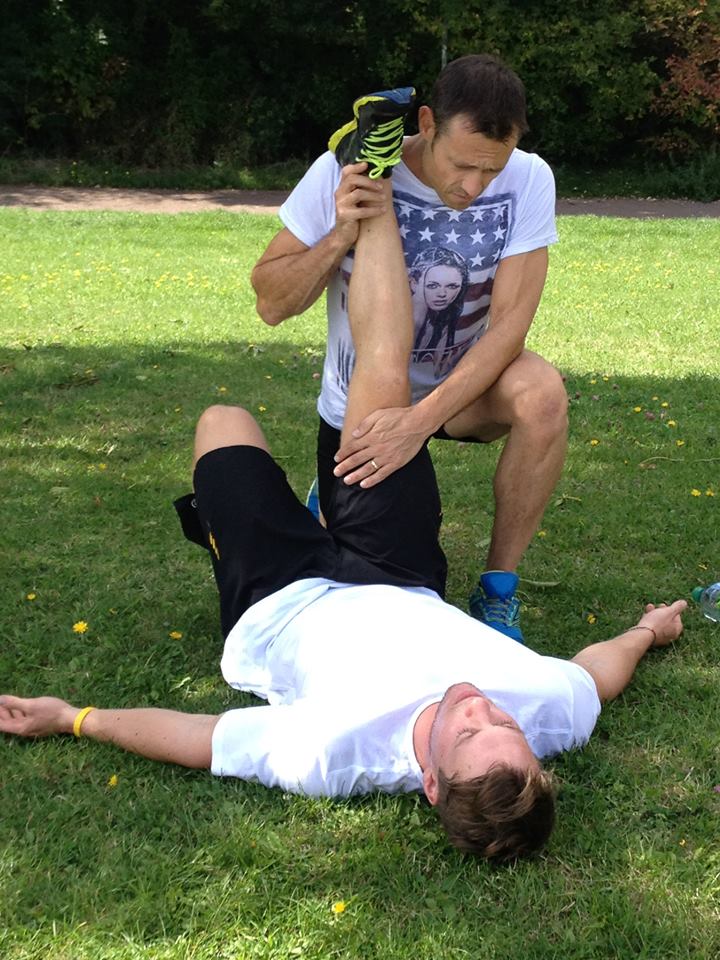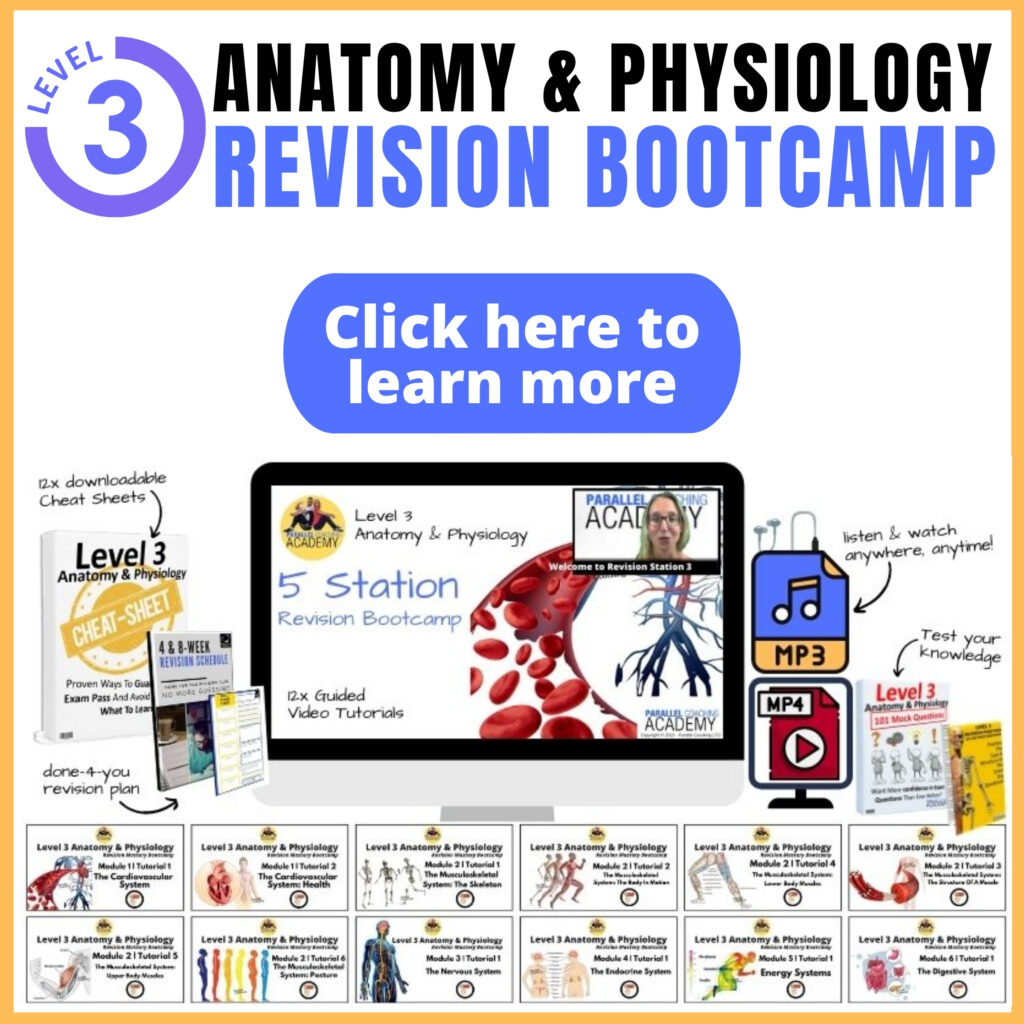This blog will explain why every client should stretch and HOW to instruct an effective stretch in a cool down.
You’ll discover:
- 5 Reasons why every client should stretch
- What is stretching?
- Physiological changes when we stretch?
- What is a PNF stretch?
- How does a PNF stretch?
- Three Mock Questions to STRETCH your knowledge
Top 5 reasons why every client should stretch:
1. Rectify muscular imbalances and correct poor posture – which is exacerbated by sitting down a lot. Stretching commonly tight muscles (including the chest, hip flexors, hamstrings, adductors and low back) will help correct common postural deviations.
2. To improve flexibility and avoid back pain. The lower back, hip flexors, and hamstrings are commonly tight, which can cause mild cramping feeling and “Knotts” inside the muscle.
This results in a downward spiral of poor blood flow, cramping, pain, and tightness. Stretching these regularly helps avoid lower back pain.
3. To avoid injury – by taking the muscle through increased ROM whilst controlled, your client is less likely to get injured by sudden movements or their exercise programme.
4. To release built-up toxins – tight muscles create a network of tangled muscle fibres, which traps toxins.
Stretching realigns the fibres and helps to release these back into the blood flow, so they can be flushed out of the body.
5. Improve performance. Stretching a muscle to full range will “switch off” the muscle. Therefore, stretching the Antagonist of the targeted muscle during a warm up could encourage activation of the targeted muscles in your workout – for example, try stretching the hip flexors before a squat or running session – to really improve glute activation.

What is stretching?
Let’s kick start with a couple of definitions surrounding stretching and improving flexibility.
Cotton (1997) discussed flexibility as “a measure of the range of motion (ROM) available at a joint or group of joints”.
Whereas, Kendall et all, 1993, outline flexibility as “the ability to readily adapt to changes in position or alignment; may be expressed as normal, limited or excessive.
These two definitions show why every client should stretch as they no doubt walk into your consultation with a whole host of alignment issues as a result of their current and past lifestyle choices.
Our lifestyle choices exacerbate whether a joint has limited or excessive movement available.
For example, the western world adopts a triple flexed seated position for many hours each day, in the car, at home, in the workplace and on the sofa which in turn exacerbates the tightness (limited) ROM at the ankle, knee and hip.
This can further lead to further mal-alignment up the spine, shoulders and neck. So all in all, sitting for too long is probably the worst activity known to mankind.
So stretching is not just about a 5-minute token in the gym, it goes much deeper than that; we need to provide lifestyle advice to support our stretch sessions and truly get a long-term sustainable response.
What happens to the muscle when we stretch?
We know why every client should stretch, but what happens physiologically when we stretch?
The muscle attaches to a bone via a tendon having crossed a joint;
a muscle contracts and pulls on the bone which now changes the angle of the joint.
If the muscle is tight, it’s constantly shortened and therefore pulling on the bone which physically limits ROM at the joint.
In contrast, if the muscle is weak or inactive, the joint is heavily compromised and ROM can be excessive.
Within the Tendon there are Golgi Tendon Organs (GTO’s) and within the muscle, there are muscle spindles.
These two influence flexibility and stretching because of the reflex actions that they stimulate.
Let’s dig a little deeper >>
What is a Muscle Spindle?
Muscle spindles are located within muscle fibres and their main function is to send messages back from the muscle to the central nervous system to inform about its state of stretch (length of the muscle).
If the muscle is stretched, distortion of the muscle spindles causes a ‘myotatic reflex’ (automatic contraction) to come into play, thus avoiding damage through overstretching or misuse of the muscle.
This muscle spindle activation (muscle contraction) is felt as the “pull” during a stretch.
The amount and rate of contraction elicited from the stretch reflex are proportional to the amount and rate of stretching. Hence, the faster and more forceful the stretch, the faster and more forceful the reflex contraction of the stretched muscle; therefore, the greater the likelihood of the muscle tearing (particularly in an untrained muscle).
What is a Golgi Tendon Organ?
GTOs are proprioceptors located near the musculotendinous junction (where muscles and tendons join).
They are activated by a contraction in a muscle and help prevent excessive tension occurring within the muscle, or the tendon of that muscle.
In contrast to the muscle spindles, stimulation of the GTOs will cause a reflex contraction of that muscle (the inverse stretch reflex). This resulting relaxation is important for certain stretches because the inhibition of the muscle in which they are located will allow muscle fibres to lengthen and stretch further.
The relaxation that occurs in the same muscle because of GTO activation is called autogenic inhibition.
This is achieved by contracting a muscle immediately before passively stretching it. The contraction will increase GTO activation, thus increasing the subsequent muscle relaxation during the stretch. Reciprocal inhibition is the relaxing effect that occurs in a muscle when the antagonist is contracting.
This occurs to allow an easier contraction of the antagonist. Hence, contracting the antagonist’s muscle will allow for a greater stretch in the muscle being elongated.

What is PNF stretching?
There are many methods to stretching but I want to focus on Proprioceptive neuromuscular facilitation (PNF) and how this method exploits the above.
PNF (proprioceptive neuromuscular facilitation) techniques involve a partner actively stretching the participant by some combination of altering contraction and relaxation of both agonist and antagonist muscles.
Some of the different PNF techniques used include slow reversal hold, contract-relax, and hold relax.
PNF stretching is capable of producing greater improvement in flexibility compared to other techniques.
Its disadvantage is that it typically requires a partner, although stretching with a partner may have some motivational advantages for some individuals.
How does a PNF stretch?
PNF stretching usually involves a 10-second push phase followed by a 30-second relaxation phase, typically repeated three times.
Check out our lying hamstring PNF example >>
Preparation
- Your participant must be thoroughly warm first. Instruct your client to lie on the floor or mat.
- Kneel beside the client and extend the client’s leg upward. Position the back of the client’s lower leg on your nearest shoulder.
- Hold the client’s foot just below the knee. Your client’s resting leg can be straight or bent here, and arms spread to the side so they are evenly positioned and can push through the floor.
- Make sure your back is kept neutral.
Execution
- Your client should feel a stretch and have a totally straight leg.
- Hold here for 20-30 seconds or until tension fades.
- Ask your client to push against your shoulder with approximately 40-70% of their strength, using their hamstrings isometrically.
- Hold this isometric contraction for 10-seconds and then ask them to relax.
- As they relax gently push your participant’s leg in the direction towards their chest, to increase the stretch.
- Hold this stretch for another 20-30secs or until tension fades, then repeat the contraction and relaxation phases for 3-4 intervals.
- Every stretch phase should increase the range of movement gradually.
- Once the intervals have been completed, shake out your client’s leg and remember to do the same on the other leg.
PNF stretching is a great way to develop flexibility and you will see immediate and long-lasting results with your clients. Make sure you monitor intensity throughout and only do PNF once fully warm
Test your knowledge with 3 stretching Mock Questions
Look at the 3 stretching Mock questions below and jot down your answer on scrap paper or as a note on your phone.
Then scroll down to reveal the answers.
[NOTE: The answers are below the 3rd question]
1. Which proprioceptor senses length in the muscle?
A. Golgi Tendon Organ
B. Muscle SPindle
C. Actin and Myosin
D. Baroreceptors
2. What does the acronym PNF stand for?
A. Peripheral Nerve Firing
B. Propriocetive Neural Familiarisation
C. Painful Neural Facilitation
D. Proprioceptive Neuromuscular Facilitation
3. What is NOT a benefit of regular flexibility work?
A. Lower risk of injury
B. Improved performance
C. Tighter muscles around a joint
D. Correction of postural compensations
What’s the CORRECT answer?
Answers to the mock questions are :
Question 1= B, Question 2 = D, Question 3 = C
If you want more mock questions like this, then you can download more Free Mock Questions: DOWNLOAD NOW

Need More Help with your Fitness Exam Revision?
Here’s what Lydia had to say about the A&P Revision Mastery Bootcamp
I can’t recommend Parallel Coaching enough their learning material is fantastic and definitely was a huge factor in me passing my A&P exam.
Lydia
Discover How 6500+ Fitpros In Training Are Walking Into Their Exam With Confidence And Guaranteeing A Pass
Are you tired of staring at your manual and not knowing where to start?
Our revision Bootcamp breaks everything down into a clear and easy-to-follow structure.
You can download the videos to MP3 and MP4 to slice your revision time in half and finally understand the key principles of exercise.
This is not another course with more exams – it HELPS pass the course you’re already enrolled on!
“EVERYTHING You Need To Learn, Revise And Pass Your Fitness Exam”
If you want to get your revision structured, learn everything you need to know and feel confident on exam day, then click the link below:
https://courses.parallelcoaching.co.uk/products/level-3-anatomy–physiology-revision-bootcamp

Hayley “Every client should stretch” Bergman
Parallel Coaching
P.S. You can also find us on the following platforms:
Instagram: https://www.instagram.com/parallelcoaching
Facebook: https://www.facebook.com/ParallelCoaching
Twitter: https://twitter.com/ParallelCoach
YouTube: http://bit.ly/2F1Z1bs
More blogs about stretching >> HERE

